Abstract
A facultatively anaerobic, gram-negative, non-sporeforming, motile rod-shaped bacterium was isolated from methanogenic consortia degrading 3-methoxy-4-hydroxycinnamate (ferulate). Consortia were originally enriched from a laboratory anaerobic digester fed sewage sludge. In the absence of exogenous electron acceptors and with the addition of 0.1% yeast extract, the isolated bacterium transformed ferulate under strictly anaerobic conditions (N2-CO2 gas phase). Ferulate (1.55 mM) was demethoxylated and dehydroxylated with subsequent reduction of the side chain, resulting in production of phenylpropinate and phenylacetate. Under aerobic conditions, the substrate was completely degraded, with transient appearance of caffeate as the first aromatic intermediate and beta-ketoadipate as an aliphatic intermediate. The pure culture has been tentatively assigned to the genus Enterobacter with the type strain DG-6 (ATCC 35929). Tentative pathways for both fermentative and oxidative degradation of ferulate are now proposed.
Full text
PDF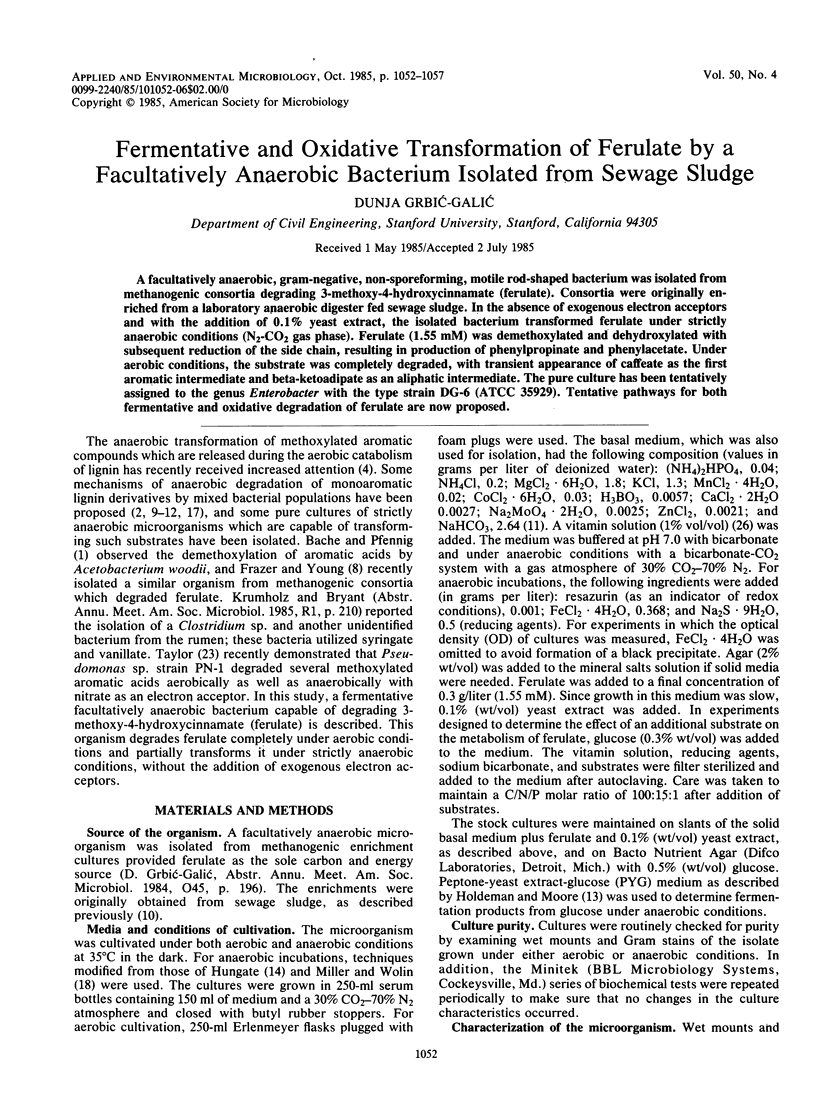
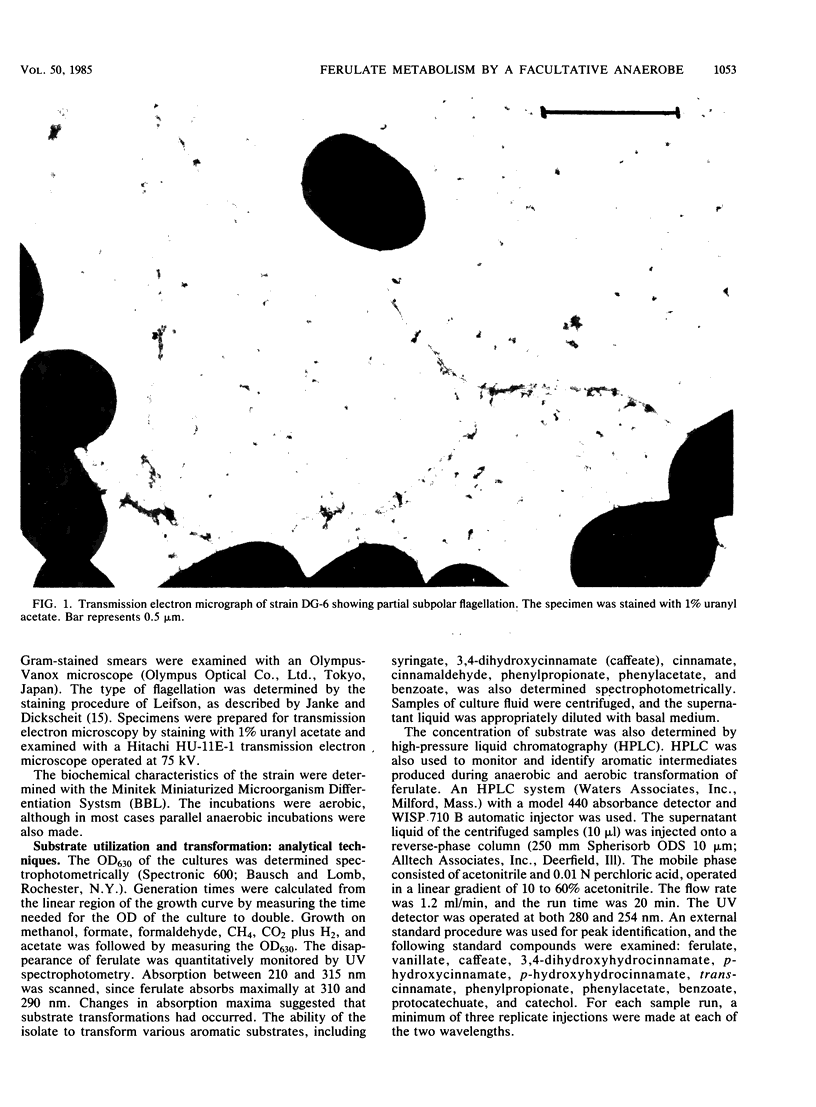
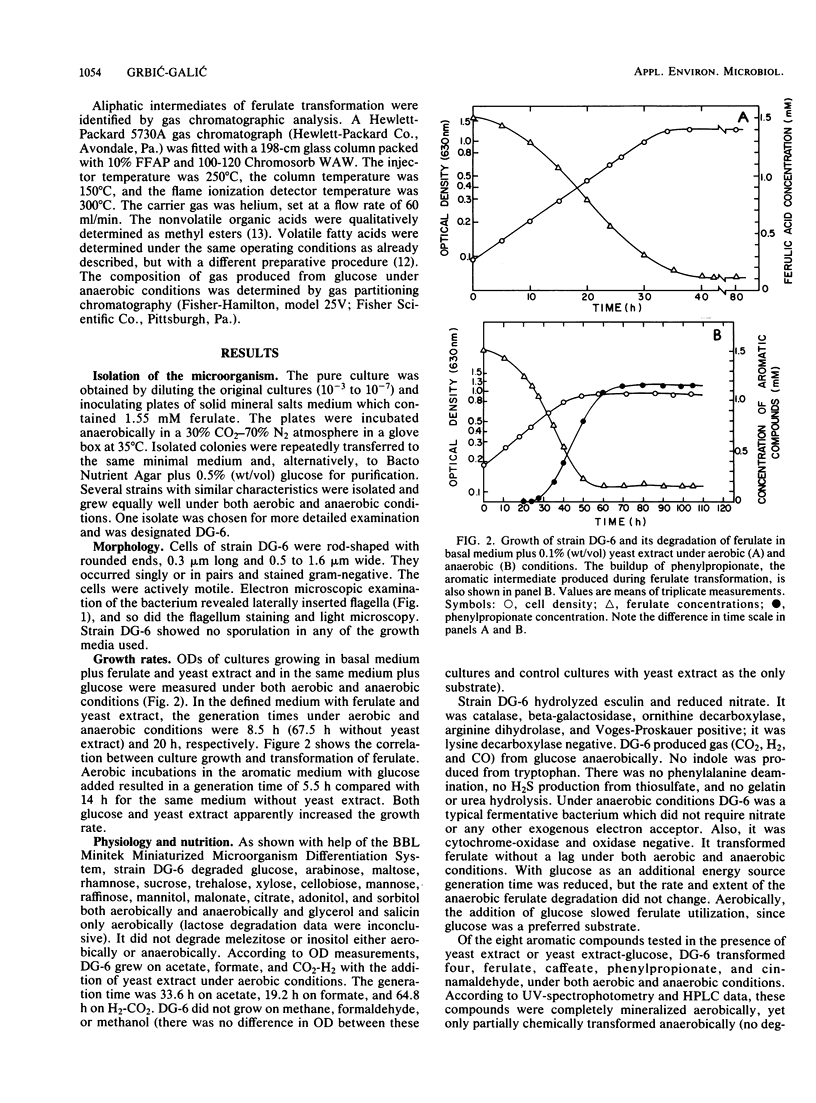
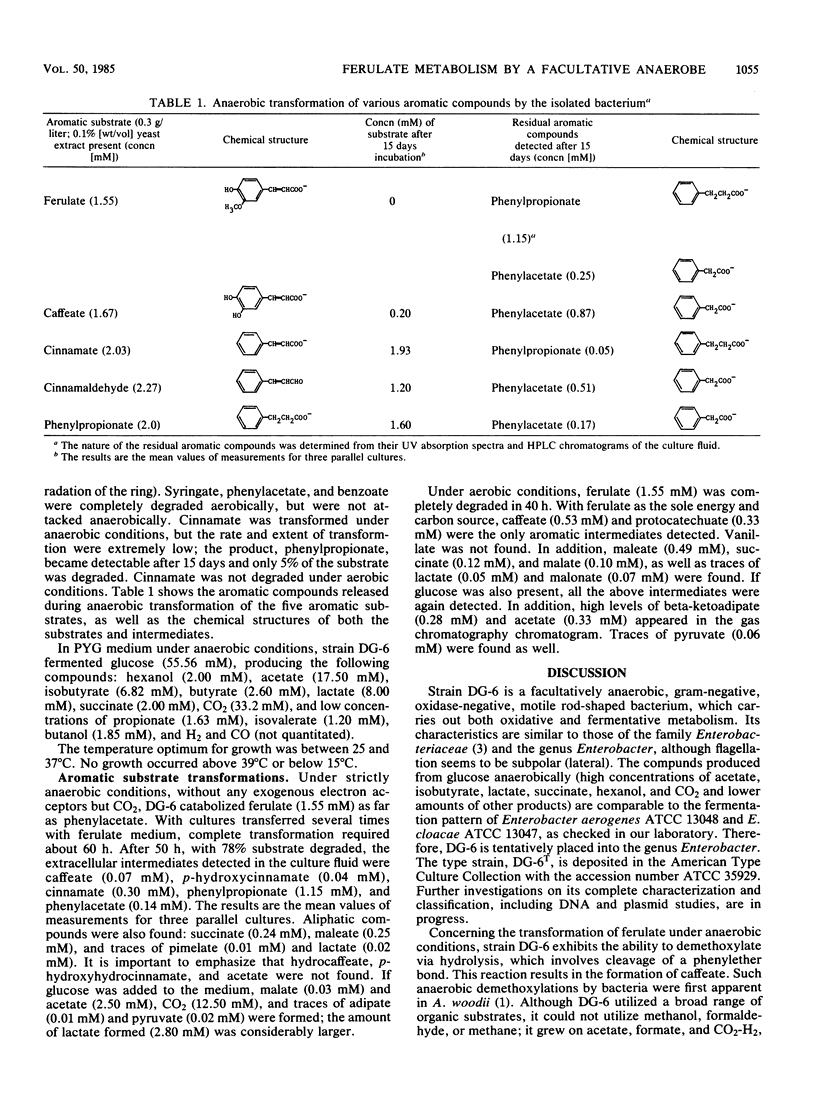
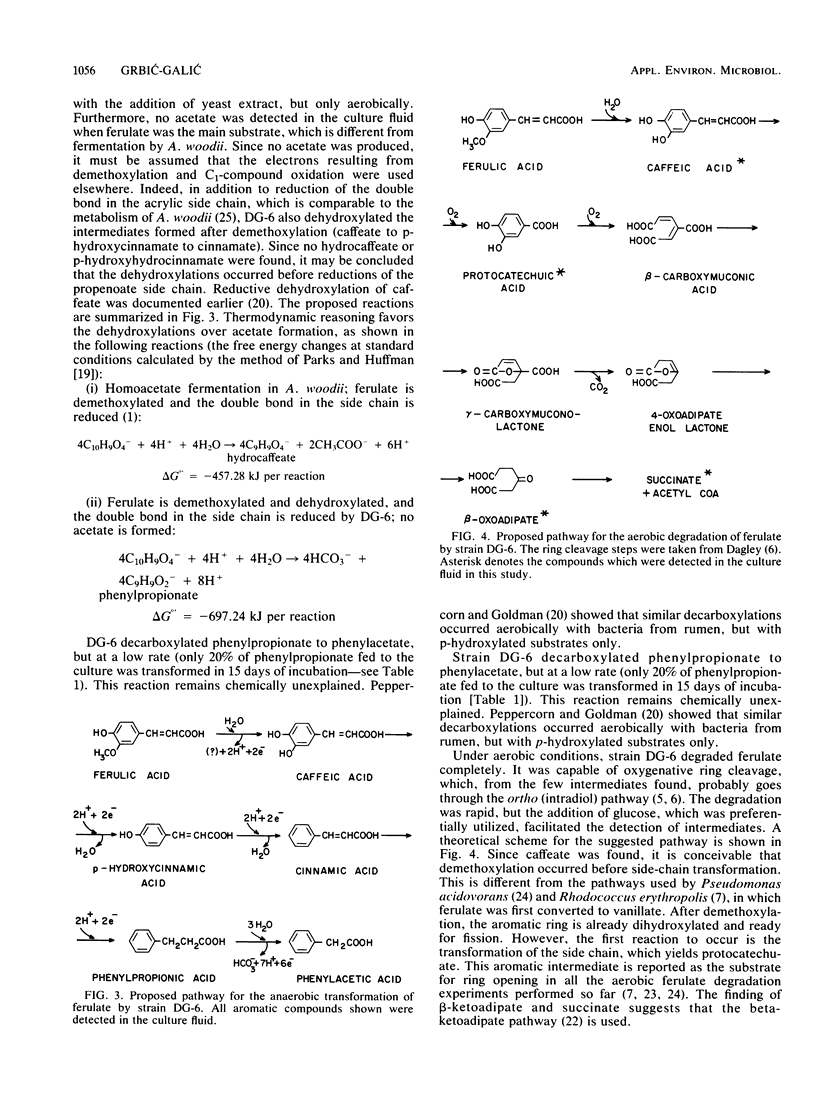
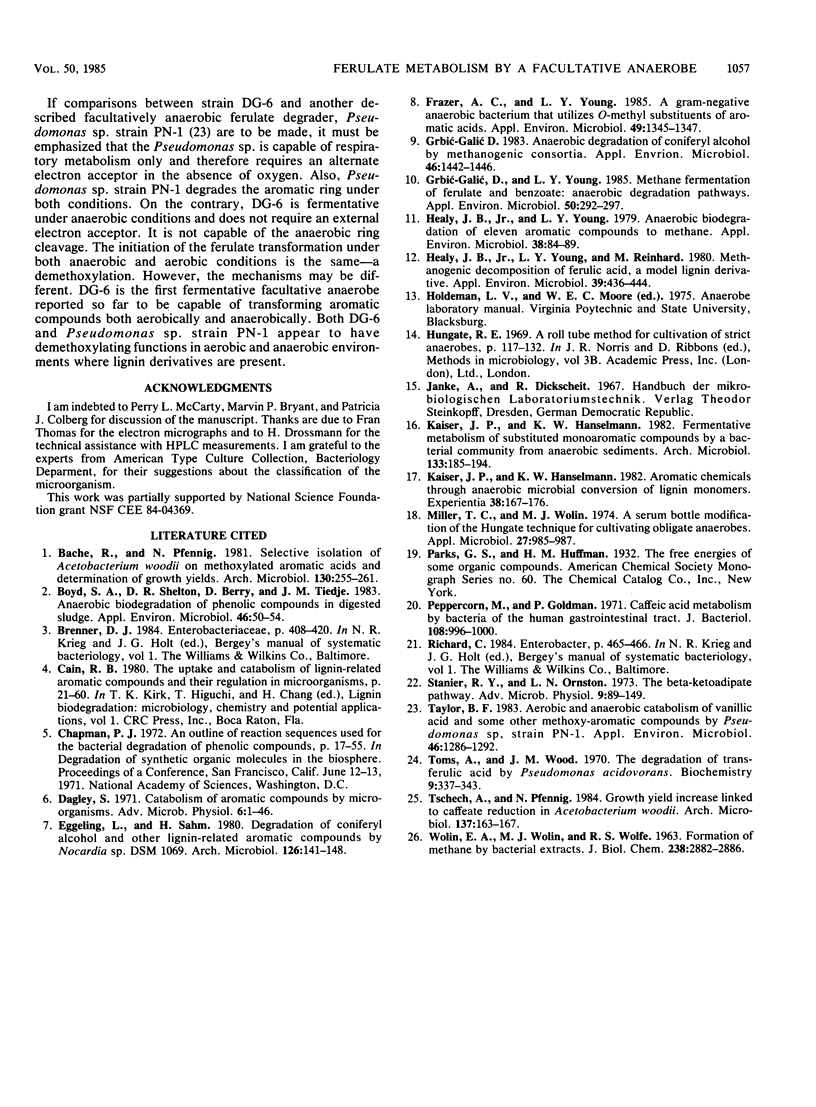
Images in this article
Selected References
These references are in PubMed. This may not be the complete list of references from this article.
- Boyd S. A., Shelton D. R., Berry D., Tiedje J. M. Anaerobic biodegradation of phenolic compounds in digested sludge. Appl Environ Microbiol. 1983 Jul;46(1):50–54. doi: 10.1128/aem.46.1.50-54.1983. [DOI] [PMC free article] [PubMed] [Google Scholar]
- Dagley S. Catabolism of aromatic compounds by micro-organisms. Adv Microb Physiol. 1971;6(0):1–46. doi: 10.1016/s0065-2911(08)60066-1. [DOI] [PubMed] [Google Scholar]
- Frazer A. C., Young L. Y. A gram-negative anaerobic bacterium that utilizes o-methyl substituents of aromatic acids. Appl Environ Microbiol. 1985 May;49(5):1345–1347. doi: 10.1128/aem.49.5.1345-1347.1985. [DOI] [PMC free article] [PubMed] [Google Scholar]
- Grbić-Galić D. Anaerobic degradation of coniferyl alcohol by methanogenic consortia. Appl Environ Microbiol. 1983 Dec;46(6):1442–1446. doi: 10.1128/aem.46.6.1442-1446.1983. [DOI] [PMC free article] [PubMed] [Google Scholar]
- Grbić-Galić D., Young L. Y. Methane fermentation of ferulate and benzoate: anaerobic degradation pathways. Appl Environ Microbiol. 1985 Aug;50(2):292–297. doi: 10.1128/aem.50.2.292-297.1985. [DOI] [PMC free article] [PubMed] [Google Scholar]
- Healy J. B., Young L. Y. Anaerobic biodegradation of eleven aromatic compounds to methane. Appl Environ Microbiol. 1979 Jul;38(1):84–89. doi: 10.1128/aem.38.1.84-89.1979. [DOI] [PMC free article] [PubMed] [Google Scholar]
- Healy J. B., Young L. Y., Reinhard M. Methanogenic decomposition of ferulic Acid, a model lignin derivative. Appl Environ Microbiol. 1980 Feb;39(2):436–444. doi: 10.1128/aem.39.2.436-444.1980. [DOI] [PMC free article] [PubMed] [Google Scholar]
- Miller T. L., Wolin M. J. A serum bottle modification of the Hungate technique for cultivating obligate anaerobes. Appl Microbiol. 1974 May;27(5):985–987. doi: 10.1128/am.27.5.985-987.1974. [DOI] [PMC free article] [PubMed] [Google Scholar]
- Peppercorn M. A., Goldman P. Caffeic acid metabolism by bacteria of the human gastrointestinal tract. J Bacteriol. 1971 Dec;108(3):996–1000. doi: 10.1128/jb.108.3.996-1000.1971. [DOI] [PMC free article] [PubMed] [Google Scholar]
- Stanier R. Y., Ornston L. N. The beta-ketoadipate pathway. Adv Microb Physiol. 1973;9(0):89–151. [PubMed] [Google Scholar]
- Taylor B. F. Aerobic and Anaerobic Catabolism of Vanillic Acid and Some Other Methoxy-Aromatic Compounds by Pseudomonas sp. Strain PN-1. Appl Environ Microbiol. 1983 Dec;46(6):1286–1292. doi: 10.1128/aem.46.6.1286-1292.1983. [DOI] [PMC free article] [PubMed] [Google Scholar]
- Toms A., Wood J. M. The degradation of trans-ferulic acid by Pseudomonas acidovorans. Biochemistry. 1970 Jan 20;9(2):337–343. doi: 10.1021/bi00804a021. [DOI] [PubMed] [Google Scholar]
- WOLIN E. A., WOLIN M. J., WOLFE R. S. FORMATION OF METHANE BY BACTERIAL EXTRACTS. J Biol Chem. 1963 Aug;238:2882–2886. [PubMed] [Google Scholar]



